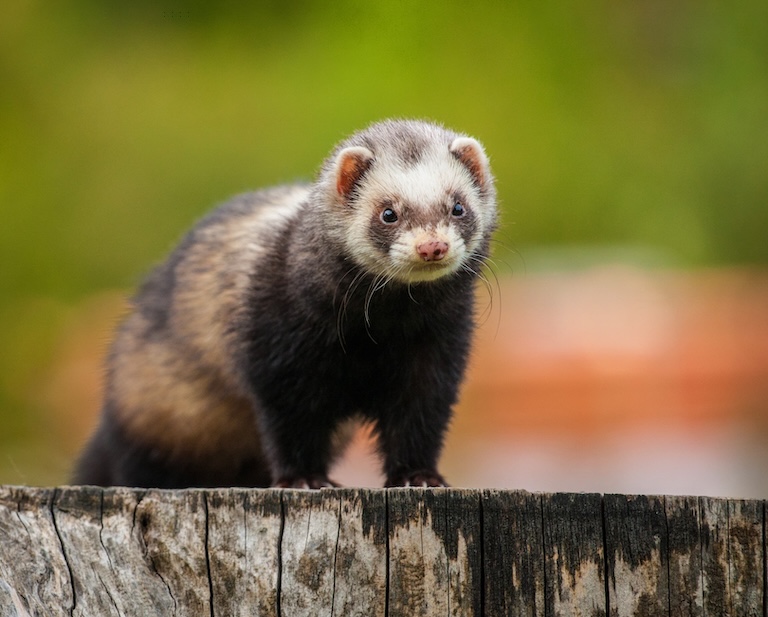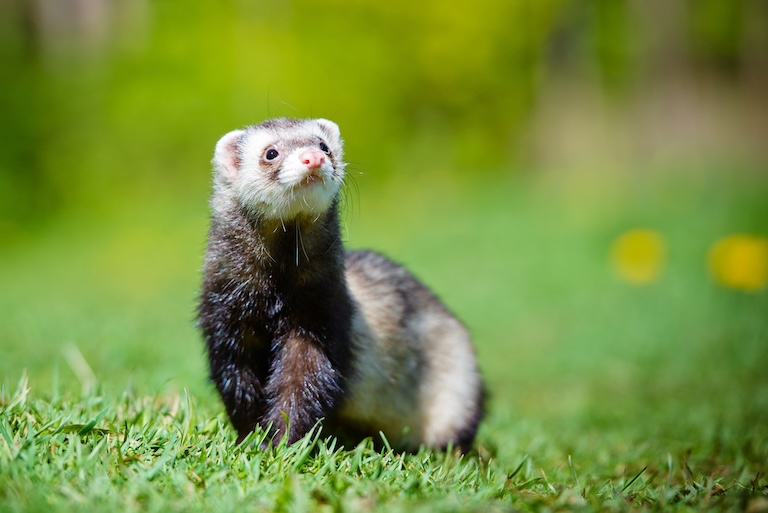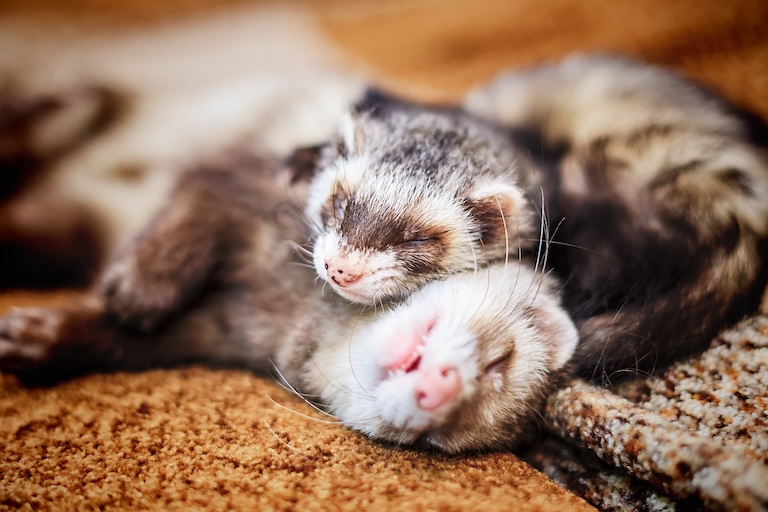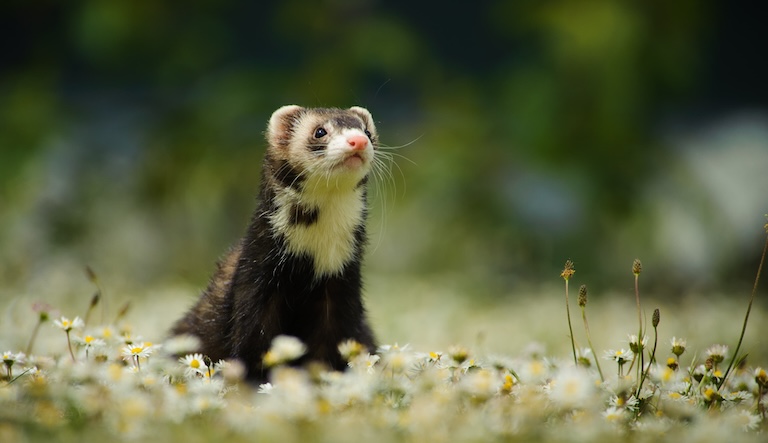Ferret Profile
Wild mustelids are an entire family of carnivores that are generally under-represented in nature documentaries on account of them looking disarmingly small and cute.
But there are some exceptions: the infamous honey badger is a good one; an example of an animal so tough and fearless it’s meme-worthy.
But there’s nothing outstanding about the honey badger that can’t be found in pretty much all mustelids, and if you take all that concentrated badassery and domesticate it, what comes out is a massive weasel as capable of hunting rabbits as it is sleeping up the sleeve of your jumper.

Ferret Facts Overview
| Habitat: | Domestic |
| Location: | Worldwide |
| Lifespan: | 5-10 years |
| Size: | Up to 50 cm (20 in) |
| Weight: | Up to 2kg (4.4 lb) |
| Colour: | Varied: brown, black, white or mixed |
| Diet: | Obligate carnivores: meat, organs, bones, fur, cat food |
| Predators: | None |
| Top Speed: | Not recorded |
| No. of Species: | 1 |
| Conservation Status: | Not Listed |
Ferrets were originally domesticated for hunting, but it soon became apparent that they’re equally good as companion animals and now there’s an almost cult-like following among those who’ve ever lived with one.
They’re likely descended from polecats, which makes them large, agile, and ferocious predators with a reputation for escape.
This has led to them setting up shop in places that they really shouldn’t, and they have become one of the most devastating invasive species in New Zealand.
Interesting Ferret Facts
1. They’re probably polecats
The weasel genus, Mustela is home to a lot of adorable killers, and it can be hard to tell them apart. The ferret was domesticated from one of them, most likely the largest: the polecat, Mustela putorius.
This is evident by the fact that the ferret and polecat can hybridise and produce fertile offspring, but the exact place and time of this domestication remains a bit of a mystery.
There’s still so much similarity between the two in terms of looks, that unless it’s a particularly unusual ferret, it can often be impossible to tell them apart reliably without a DNA test or by removing their skulls to check for specific markers in the bone.
While we don’t know exactly when they were domesticated, we know that they date as far back as the Mongol empire. 1

2. Genghis had ferrets
The best guess we can find is that the ferret originated around 2,500 years ago, having been bred from a North African population of the European polecat.
Since then this incredible mustelid did the rounds, being written about by Aristotle, then Pliny in Historia naturalis, and known to be used by the Ancient Romans for hunting rabbits.
It even took part in some of the infamous rampages of the imperial genius/terrible rapist and murderer Genghis Kahn.
He was said to have used ferrets in the Winter of 1221, as part of a months-long hunting drive in which pretty much anything that could move, fled into the bottlenecks made by hunters and was slaughtered in classic imperial fashion with “spades, mattocks, and ferrets”.
3. They’re little thieves
It is the Romans who likely gave us the name ferret, which comes from furittus, meaning “little thief”. Knowing mustelids, this is almost certainly a reference to their ability to steal chickens or any kind of meat from the larder, and it is this agility, coupled with their strength, that makes them incredible hunters.
Still, like all accomplished killers, they rest a lot.
4. They’re sleepy animals
Ferrets spend up to 18 hours a day sleeping and maintain the crepuscular (awake at dawn and dusk) nature of their polecat ancestry.
As pets, this could make them a bit boring, but unlike their solitary ancestors, they are very sociable and loving animals that don’t mind being disturbed as long as they get their rest.
This combination of highly intelligent, wriggly, social, and densely fluffy animals makes them extremely popular as pets, but they have a bit of a stinky downside when kept indoors.

5. And can be very smelly
Skunks are notorious for what comes out of their back ends, but they’re not the only mustelids who can kick up a stink.
In fact, all mustelids can, and ferrets are no exception. While not as sticky and persistent as the skunk’s, the anal secretions of a ferret are nothing to sniff at, and the animals are often sold with their anal glands surgically removed when bought in pet shops in the US.
In more sensible places, like most of Europe, this is deemed mutilation and is illegal. This is great news, but does mean that owners have to be wary of what they’re getting into. 2
6. They still make excellent pets
There’s little not to love about ferrets, aside from the stink and the fact they’ll kill your chickens. They are smart, cuddly and full of character, and they tend to get on well with other household animals too, as long as they’re not small enough to be eaten or big enough to eat the ferret.
There’s even a National Ferret Day in the US, to celebrate how awesome they are.
Still, they are powerful enough to kill a hare, so all precautions should be made to rear one that won’t bite your finger off. Children aren’t the best at doing this, so adult supervision is advised.
As for diet, they can more or less eat like a cat would. 3
7. They need meat
It is possible for a dog to live a perfectly healthy – or even healthier – life on a vegan diet if it’s formulated by someone who knows exactly what they’re doing.
Unfortunately, this isn’t the case for obligate carnivores, and there have been cases of some very ignorant people killing their cats by withholding meat from them.
The same is true for ferrets. Pet ferrets can mostly get by on cat food but there are also specialist ferret foods available if owners want to make it simple, and these will be even better.
Otherwise, they can be fed all kinds of animal prey as you would feed a snake: defrosted rabbits or mice are easy to come by and closely match the wild diet of the ancestral polecat.
Ferrets are born carnivores, and meat is critical to their health. Sadly, when they escape, this becomes a bit of an issue. 4

8. They’ve gone feral
Being sneaky thieves and ninjas, it’s unsurprising that ferrets have escaped the confines of captivity and set up shop in ecosystems that weren’t ready for them.
Probably the ecosystem that’s least ready for an invasive mustelid is New Zealand, and unfortunately, that’s exactly where one colony has made its home.
As much as Feral Ferrets of New Zealand sounds like a great indie band, it’s a very dangerous reality on the islands, as mustelids are about as successful a killer as a mammal can get and with the local fauna used to a distinct lack of predators, they’re entirely underequipped to defend themselves.
Not only are ferrets the largest mustelid introduced to NZ, but they’re also now the largest feral ferret colony in the world, and this is seriously bad news for the birds, amphibians and bats that are being massacred by these incredible animals. 5
Ferret Fact-File Summary
Scientific Classification
| Kingdom: | Animalia |
| Phylum: | Chordata |
| Class: | Mammalia |
| Order: | Carnivora |
| Family: | Mustelidae |
| Genus: | Mustela |
| Species: | furo |
Fact Sources & References
- “A History of the Ferret”, Sci Hub.
- “The buzz”, Forest Preserve District Willcountry.
- Jenny Kutner (2014), “Is This Ferret Faster Than A Remote-Controlled Race Car?”, the dodo.
- Damian Carrington (2022), “Like a dog with a bean … vegan diets found to aid canine health”, The Guardian.
- “5 surprising things about ferrets in New Zealand (and why they are such a threat to native manu)”, L&L.
